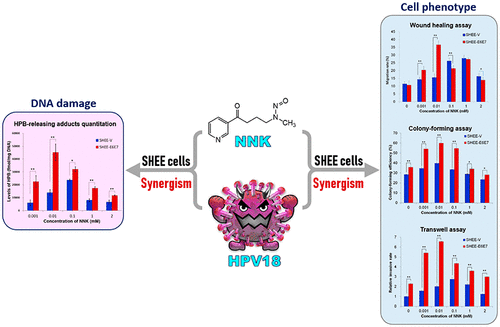当前位置:
X-MOL 学术
›
Chem. Res. Toxicol.
›
论文详情
Our official English website, www.x-mol.net, welcomes your
feedback! (Note: you will need to create a separate account there.)
Synergistic Effect between Human Papillomavirus 18 and 4-(Methylnitrosamino)-1-(3-pyridyl)-1-butanone on Malignant Transformation of Immortalized SHEE Cells.
Chemical Research in Toxicology ( IF 3.7 ) Pub Date : 2020-01-09 , DOI: 10.1021/acs.chemrestox.9b00371 Zhuochen Zhuang 1 , Jintao Li 1 , Guohui Sun 1 , Xin Cui 1 , Na Zhang 1 , Lijiao Zhao 1 , Paul K S Chan 2 , Rugang Zhong 1
Chemical Research in Toxicology ( IF 3.7 ) Pub Date : 2020-01-09 , DOI: 10.1021/acs.chemrestox.9b00371 Zhuochen Zhuang 1 , Jintao Li 1 , Guohui Sun 1 , Xin Cui 1 , Na Zhang 1 , Lijiao Zhao 1 , Paul K S Chan 2 , Rugang Zhong 1
Affiliation

|
4-(Methylnitrosamino)-1-(3-pyridyl)-1-butanone (NNK) is an important tobacco-specific nitrosamine (TSNA) that induces malignant tumors in rodents. High-risk human papillomavirus (hr-HPV) infection is an important cause of several human cancers. Epidemiological evidence has shown that HPV cooperatively induces carcinogenesis with tobacco smoke. In the present study, the synergistic carcinogenesis of NNK and HPV18 was investigated. Immortalized human esophageal epithelial SHEE cells containing the HPV18 E6E7 gene were constructed by lentiviral transfection. SHEE-E6E7 cells were exposed to NNK along with SHEE-V cells without HPV18 E6E7 as a negative control. The cooperation of NNK and HPV was examined by wound-healing, transwell, and colony-forming assays. The results showed that NNK exposure promoted the migration, invasion, and proliferation abilities of both SHEE-E6E7 and SHEE-V cells; however, the changes in these phenotypic features were remarkably stronger in SHEE-E6E7 cells than those in SHEE-V cells. Our findings indicate that NNK promotes malignant transformation of human esophageal epithelial cells and suggest a synergistic carcinogenesis with the HPV18 E6E7 oncogene. As reported previously, the formation of pyridyloxybutylated DNA adducts is a crucial step in NNK-mediated carcinogenesis. In order to clarify the influence of HPV on the formation of NNK-induced DNA adducts, the amounts of 4-hydroxy-1-(3-pyridyl)-1-butanone (HPB)-releasing DNA adducts were determined using high-performance liquid chromatography-electrospray ionization-tandem mass spectrometry. We observed that the levels of HPB-releasing adducts in SHEE-E6E7 cells were significantly higher (p < 0.01) than those of SHEE-V cells, which was in line with results of the phenotypic assays. In conclusion, this study provides direct evidence that NNK and HPV18 exhibit a synergistic effect on formation of DNA adducts, resulting in malignant transformation of esophageal epithelial cells. Such knowledge on the interaction between infection and smoking habits in the development of cancers informs cancer-prevention strategies. Further studies to delineate the molecular mechanism and to identify specific intervention targets are worthwhile.
中文翻译:

人乳头瘤病毒18和4-(甲基亚硝胺基)-1-(3-吡啶基)-1-丁酮对永生化SHEE细胞恶性转化的协同作用。
4-(甲基亚硝胺基)-1-(3-吡啶基)-1-丁酮(NNK)是一种重要的烟草特异性亚硝胺(TSNA),可在啮齿动物中诱发恶性肿瘤。高危人类乳头瘤病毒(hr-HPV)感染是几种人类癌症的重要原因。流行病学证据表明,HPV与烟草烟雾协同诱导致癌作用。在本研究中,对NNK和HPV18的协同致癌作用进行了研究。通过慢病毒转染构建了包含HPV18 E6E7基因的永生化人食管上皮SHEE细胞。将SHEE-E6E7细胞与不含HPV18 E6E7的SHEE-V细胞一起暴露于NNK作为阴性对照。NNK和HPV的合作通过伤口愈合,transwell和集落形成分析进行了检查。结果表明,NNK暴露促进了迁移,侵袭,SHEE-E6E7和SHEE-V细胞的增殖能力;然而,这些表型特征的变化在SHEE-E6E7细胞中明显强于SHEE-V细胞。我们的发现表明,NNK促进人食道上皮细胞的恶性转化,并提示与HPV18 E6E7癌基因的协同致癌作用。如前所述,吡啶氧基氧基丁基化DNA加合物的形成是NNK介导的癌变过程中的关键步骤。为了阐明HPV对NNK诱导的DNA加合物形成的影响,使用高效能液体确定了释放4-羟基-1-(3-吡啶基)-1-丁酮(HPB)的DNA加合物的量。色谱-电喷雾电离串联质谱法。我们观察到,SHEE-E6E7细胞中HPB释放加合物的水平显着高于SHEE-V细胞(p <0.01),这与表型分析的结果一致。总之,这项研究提供了直接的证据,表明NNK和HPV18对DNA加合物的形成具有协同作用,从而导致食管上皮细胞发生恶性转化。对癌症发展过程中感染与吸烟习惯之间相互作用的了解有助于预防癌症。划定分子机制并确定具体干预目标的进一步研究是值得的。这项研究提供了直接的证据,表明NNK和HPV18对DNA加合物的形成具有协同作用,从而导致食管上皮细胞发生恶性转化。对癌症发展过程中感染与吸烟习惯之间相互作用的了解有助于预防癌症。划定分子机制并确定具体干预目标的进一步研究是值得的。这项研究提供了直接的证据,表明NNK和HPV18对DNA加合物的形成具有协同作用,从而导致食管上皮细胞发生恶性转化。对癌症发展过程中感染与吸烟习惯之间相互作用的了解有助于预防癌症。划定分子机制并确定具体干预目标的进一步研究是值得的。
更新日期:2020-01-09
中文翻译:

人乳头瘤病毒18和4-(甲基亚硝胺基)-1-(3-吡啶基)-1-丁酮对永生化SHEE细胞恶性转化的协同作用。
4-(甲基亚硝胺基)-1-(3-吡啶基)-1-丁酮(NNK)是一种重要的烟草特异性亚硝胺(TSNA),可在啮齿动物中诱发恶性肿瘤。高危人类乳头瘤病毒(hr-HPV)感染是几种人类癌症的重要原因。流行病学证据表明,HPV与烟草烟雾协同诱导致癌作用。在本研究中,对NNK和HPV18的协同致癌作用进行了研究。通过慢病毒转染构建了包含HPV18 E6E7基因的永生化人食管上皮SHEE细胞。将SHEE-E6E7细胞与不含HPV18 E6E7的SHEE-V细胞一起暴露于NNK作为阴性对照。NNK和HPV的合作通过伤口愈合,transwell和集落形成分析进行了检查。结果表明,NNK暴露促进了迁移,侵袭,SHEE-E6E7和SHEE-V细胞的增殖能力;然而,这些表型特征的变化在SHEE-E6E7细胞中明显强于SHEE-V细胞。我们的发现表明,NNK促进人食道上皮细胞的恶性转化,并提示与HPV18 E6E7癌基因的协同致癌作用。如前所述,吡啶氧基氧基丁基化DNA加合物的形成是NNK介导的癌变过程中的关键步骤。为了阐明HPV对NNK诱导的DNA加合物形成的影响,使用高效能液体确定了释放4-羟基-1-(3-吡啶基)-1-丁酮(HPB)的DNA加合物的量。色谱-电喷雾电离串联质谱法。我们观察到,SHEE-E6E7细胞中HPB释放加合物的水平显着高于SHEE-V细胞(p <0.01),这与表型分析的结果一致。总之,这项研究提供了直接的证据,表明NNK和HPV18对DNA加合物的形成具有协同作用,从而导致食管上皮细胞发生恶性转化。对癌症发展过程中感染与吸烟习惯之间相互作用的了解有助于预防癌症。划定分子机制并确定具体干预目标的进一步研究是值得的。这项研究提供了直接的证据,表明NNK和HPV18对DNA加合物的形成具有协同作用,从而导致食管上皮细胞发生恶性转化。对癌症发展过程中感染与吸烟习惯之间相互作用的了解有助于预防癌症。划定分子机制并确定具体干预目标的进一步研究是值得的。这项研究提供了直接的证据,表明NNK和HPV18对DNA加合物的形成具有协同作用,从而导致食管上皮细胞发生恶性转化。对癌症发展过程中感染与吸烟习惯之间相互作用的了解有助于预防癌症。划定分子机制并确定具体干预目标的进一步研究是值得的。











































 京公网安备 11010802027423号
京公网安备 11010802027423号